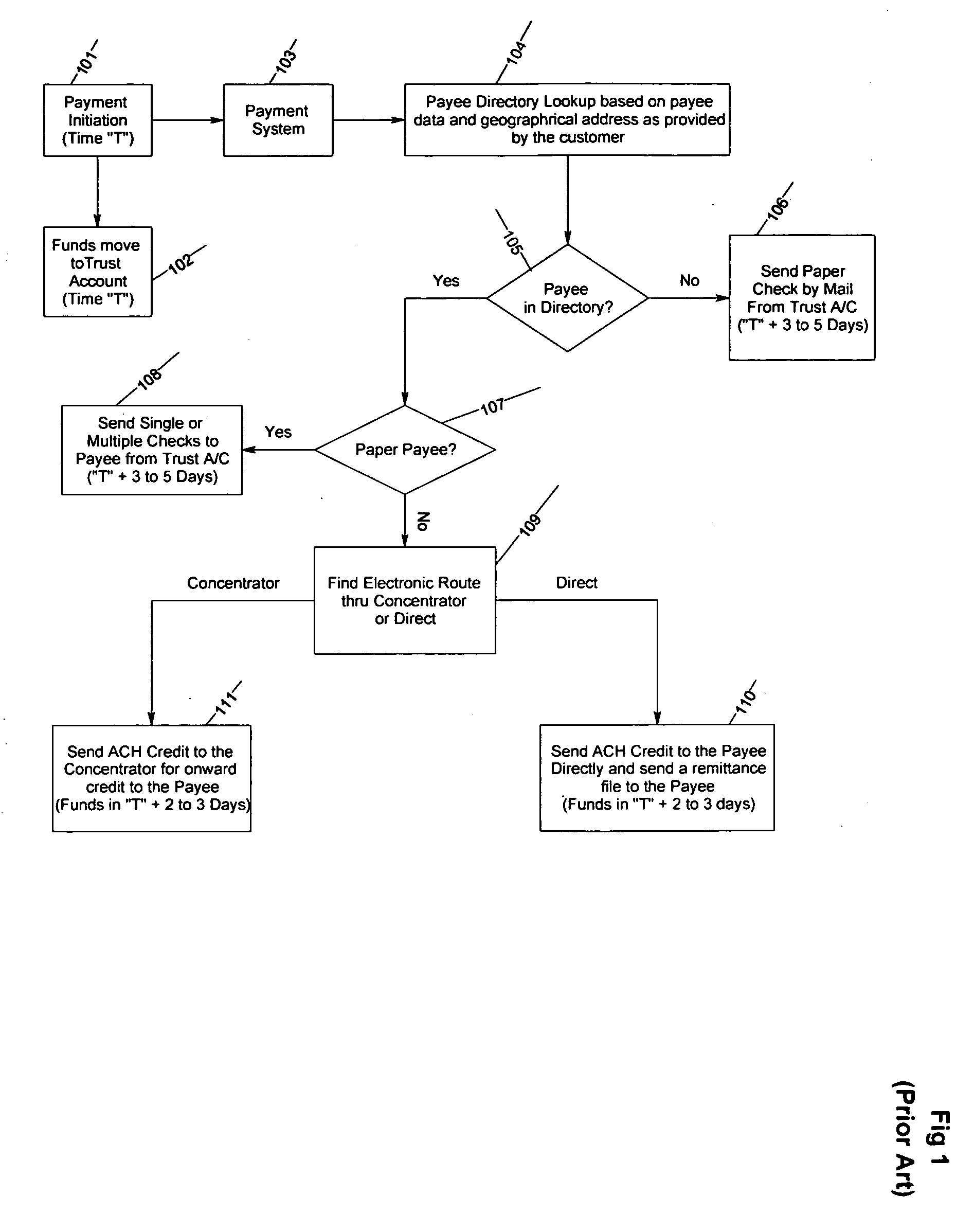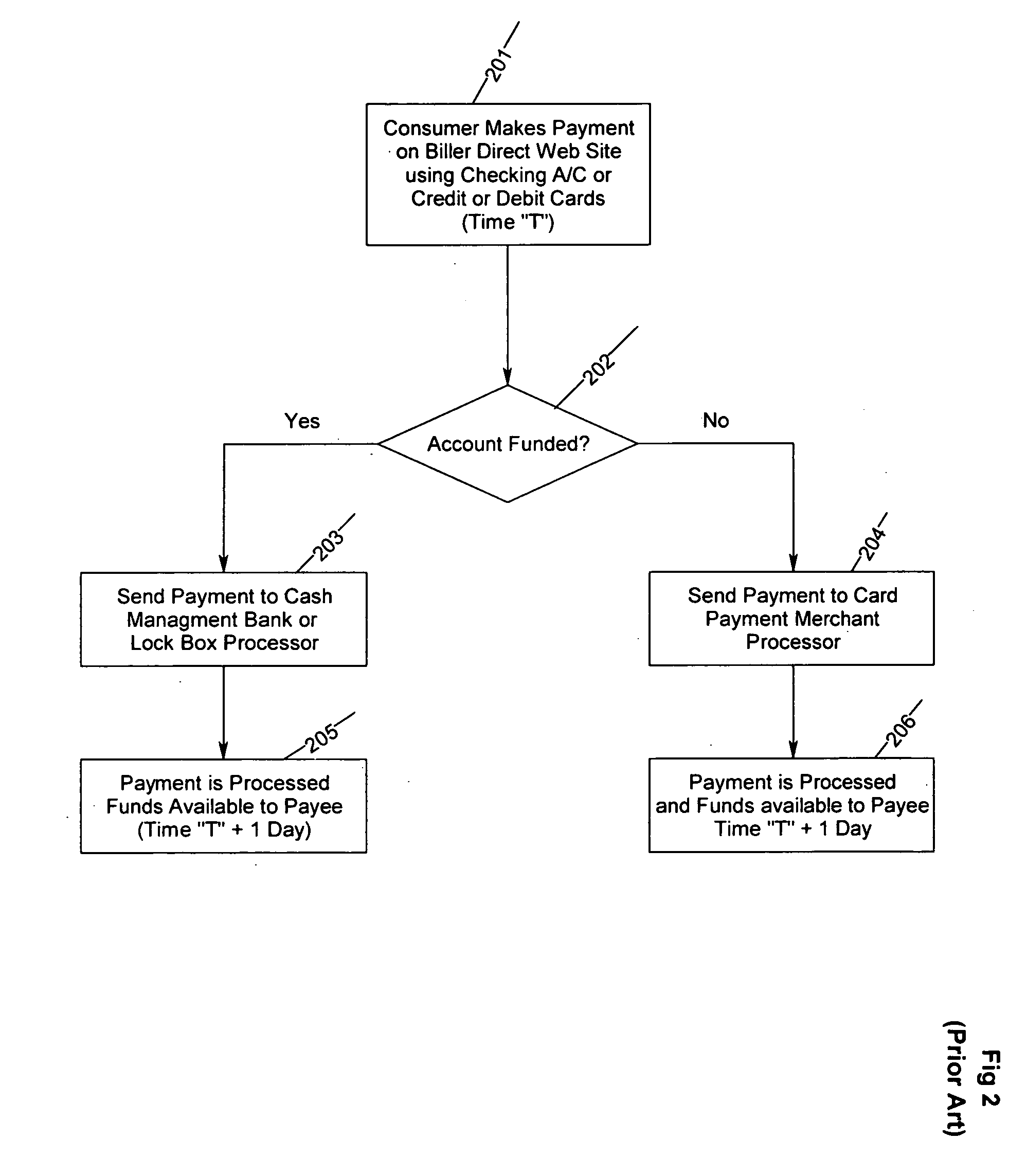tion. However, although many enhancements have been brought to these applications over the years, but fundamentally PayAnyOne applications have simply remained the same and continue to suffer from very strong operational inefficiencies created due to the assumption of an unknown payee; and any payee entered by the user is a valid payee; and the payee identification is only done by the address information provided by the user with its own writing style prefer
This poses a significant challenge to the financial institutions billpay offering, so much so that financial institutions have to forego charging customers for this service.
The market is now at a inflexion point where financial institutions are having to incur significant cost due to inefficient billpay payanyone application providers and can not see tangible revenues associated with the cost.
It takes many days for electronic payments to settle and even more for the paper checks.
Needless to describe, if the check is lost in the mail, it creates significant customer dissatisfaction and inquiries, building up operational cost, because the customer is wondering that the payment was made, money was deducted, and still, payee received no payment.
This can sometime also cause late fees and even
discontinuation of service as there is a significant
confusion and communication gap created between all parties.
However, billpay providers and financial institutions both are also trying other means to reduce these operational, and highly customer frustrating issues by signing up more and more electronic payees whereby they contact the payee, set them up as part of the electronic payee
directory and when the payment is made to that payee, the payment fulfillment is done electronically.
Although, there is an incentive for the payee to stop paper check payments and receive them electronically, but it also creates an added problem and that is to receive multiple settlement files from multiple payment processors.
Consolidators many times wait for years before a payee is ready to accept the payments electronically through other channels due to cost / benefit challenges.
Additionally, since the fundamental assumption of these systems (“prior art”) is that payee is unknown, de-coupled and irrelevant, this also creates challenges to post electronic payments.
However, still verifying account format does not verify account ownership and creates inherent fraud and privacy issues.
Secondly, even for the electronic payees, because there is a cost involved on the payee side to accept new files from new payment processors, many a times the payments are actually sent via the payment concentrators who may already have a link to the payee by knowing their account information, bank routing information and account
mask information, in addition to creating a mutually agreed file
processing interface.
Some of these legacy systems are so rigid that minor changes in the payee data can result in treatment of the same payee differently.
To avoid that, there are other cumbersome processes created to do sanity check of the data entered by the user.
In summary, these systems because they were built on a fundamental assumption of unknown payees, has caused them to grow in complexity to drive continued operational efficiencies because of the tremendous pricing pressure from the market.
Once again, financial institutions approach to a loosely coupled payee and a tightly coupled funding account creates many more challenges which are now becoming a competitive
threat to the financial institutions and causes many restrictions as to how and when the payment is processed and what types of funding accounts are allowed for payments.
For example, this approach of bill payments does not allow card funded payments.
The way these systems are designed inherently limit the knowledge as to which payee can accept the credit cards and financial institutions are forced to tie the funding account to customer's banking account.
However, these applications are more focused on Customber to Custmoer (“C2C”) or very small volume of payment transactions and the transactions which need to be instantly settled-due to potentially an un-trusted merchant or receiving party.
There are also challenges as it relates to financial institutions ability to receive billing information.
Yet again, this continues to be a mounting challenge in the marketplace to provide customer's convenience of paying bills at one place while they can also view summary of these bills at the same site of their choosing.
However, as discussed above, bill payment is no longer an up and coming application and is part of the mainstream financial supply chain product offerings.
In good funds model, it has even a bigger user expectation management issues as the funds are taken 3-5 days before the payment is received by the payee.
This can even turn operationally
chaotic as the check may be lost and can affect user's ability to get service from the payee and many cases may include late payments.
Compounding the situation is the fact that many of the payees setup by the user may receive electronic payments and others through paper check and it is very hard to know which payments are processed and received when.
Now, the next level of complications exist is in managing the cost of processing paper payments.
The inherent and fundamental approach, design principles and basic assumptions have rendered these systems so inefficient that a payee
record of AT&T or BellSouth may be repeated one million times by one million user as the approach of identifying payees by their
physical address and that of the payee is unknown till it is known by identifying its address or a backend electronic relationship with the payee.
However, this approach has many inherent issues.
Additionally, this approach makes very hard to bring on new payees as direct electronic because a justification and value proposition needs to be created for the payee to do the integration work for receiving payments from yet another
payment processor.
Because the development and operational efforts on the billers end can be non-trivial and in many cost of converting paper to electronic out weigh the benefits, consolidated payment providers many times wait for months and even years to get a payee to convert electronically.
Because this approach to
transaction processing is based on accepting transactions for any payee which may not be known to the network, and because of the difficulties the entire conventional bill pay industry faces (including the concentrators), there is no
verification of the payee account holders' ownership of the account.
Now that this is turning into a mainstream application, the requirements are different and security, privacy and fraud are very important issues.
Because of the uncertainty and lack of
clarity in timing of the payment processing, it also results in significant operational cost resulting from calls by the user to research and trace their payment status.
As discussed above, this approach served its purpose but has outgrown its usefulness.
This poses competitive challenges to the financial institutions who offer bill payments.
Secondly, both parties are typically non-trusted entities (or unknown to each other), there is a requirement for instant settlement of payments and the service providers charge a substantial premium for processing these payments.
However, if the payment is with a trusted party and / or for large volume payments, payees and consumers do not prefer this method primarily because of the customer experience and the cost of processing each transaction as the systems have been optimized for processing small volume of small transactions.
Additionally, this requires a significant capital expenditure if built in-house or requires a substantial commitment for monthly payments for outsource provisioning of ebills capability.
Because of the cost and complexity, only the high volume billers are able to offer the functionality.
In the marketplace today, according to the conventional bill distribution in FIG. 4 there is no economical way for any biller to allow its users to see its summary bill information (Amount Due,
Payment Due Date, Minimum Due .
This also means from the time of making the decision to publish bills it can take several months to year(s) to implement.
This has created a chicken-and-egg problem for the adoption of bills at the financial institutions
web site and / or any other web billing portal.
This means a highly complex process for extracting the meaningful billing information such as payment due date, amount due etc.
Unfortunately, each of the consolidator has their own proprietary interface specification of
data set or a set of inter-related files for exchanging summary billing information.
Because bill information is very detailed, complex and requires significant amount of data storage, consolidators only want to deal with the summary bill information (Thin aggregation) and refer the user for detailed billing information to go back to the biller's
web site either synchronously through seamless login or asynchronously.
In practical aspect, this conventional approach as depicted in FIG. 4 may require up to 15 months or more for implementation, a significant challenge to biller adoption.
As evident from the aforementioned background on the prior art that the payment systems and bill payment applications currently implemented have not kept up with the changing technological advancements and are fundamentally designed with very in-efficient and rigid processes and keeping the customer from enjoying true benefits of next generation of payment systems.
In general, because the current bill pay applications at financial institutions are modeled on a “don't care about payee” or “any payee is a valid payee” assumption there are many inherent challenges with prior art systems.
 Login to View More
Login to View More  Login to View More
Login to View More 


